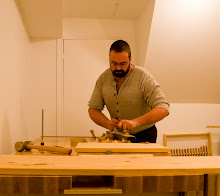 There are a whole bunch of different dovetail gauges on the market. I've bought a few, and made a couple, and these are what I have left. At the right in the image above is an adjustable bevel. This is the traditional way in many western cultures to gauge your dovetail angle. You set the bevel to the angle you want, then use it to mark the work. This works, but the adjustable bevel is relatively heavy, and the angle could creep when you set the gauge down and pick it up again for the next board, etc. The adjustability can be a drawback. The next gauges, moving to the left in the image above, are the Veritas Dovetail Markers. Very inexpensive, very light, generally inoffensive, but they lack an important feature, and that is being able to mark the angle and the square line on the adjacent face with the same tool and placement. It is a great luxury to be able to set the gauge in place and mark both lines without moving the gauge, thereby guaranteeing that the marked lines are in the same plane. The lack of this ability is a failing of the adjustable bevel, as well. At the far left in the above image we see a dovetail gauge that I made. I'd seen a gauge in Ernest Joyce's "Encyclopedia of Cabinetmaking" which I thought was almost perfect. It was a double-sided affair that had two angles on it, so that one gauge could be used for hardwoods and softwoods. Rob Cosman found the same image, and uses it, (and sells them) himself. I didn't like that it had two angles on it. It wouldn't take that much inattention to pick up the gauge and use the wrong side. Also, you had to flip the gauge over to change the direction of the angle when you're marking the other side of a dovetail. I would prefer to have one gauge for each angle that I'm likely to use. The first one I made was like Joyce's original, but I soon started modifying it, then started over when I realized that the two-angle design wasn't good for me. To this end I made mine with only one angle, but both edges have the same angle so it can do both sides of the dovetail by just sliding it back and forth. No flipping and flopping, and no chance of using the 'wrong' angle. This was the best gauge so far, and in some ways is still my best gauge.
There are a whole bunch of different dovetail gauges on the market. I've bought a few, and made a couple, and these are what I have left. At the right in the image above is an adjustable bevel. This is the traditional way in many western cultures to gauge your dovetail angle. You set the bevel to the angle you want, then use it to mark the work. This works, but the adjustable bevel is relatively heavy, and the angle could creep when you set the gauge down and pick it up again for the next board, etc. The adjustability can be a drawback. The next gauges, moving to the left in the image above, are the Veritas Dovetail Markers. Very inexpensive, very light, generally inoffensive, but they lack an important feature, and that is being able to mark the angle and the square line on the adjacent face with the same tool and placement. It is a great luxury to be able to set the gauge in place and mark both lines without moving the gauge, thereby guaranteeing that the marked lines are in the same plane. The lack of this ability is a failing of the adjustable bevel, as well. At the far left in the above image we see a dovetail gauge that I made. I'd seen a gauge in Ernest Joyce's "Encyclopedia of Cabinetmaking" which I thought was almost perfect. It was a double-sided affair that had two angles on it, so that one gauge could be used for hardwoods and softwoods. Rob Cosman found the same image, and uses it, (and sells them) himself. I didn't like that it had two angles on it. It wouldn't take that much inattention to pick up the gauge and use the wrong side. Also, you had to flip the gauge over to change the direction of the angle when you're marking the other side of a dovetail. I would prefer to have one gauge for each angle that I'm likely to use. The first one I made was like Joyce's original, but I soon started modifying it, then started over when I realized that the two-angle design wasn't good for me. To this end I made mine with only one angle, but both edges have the same angle so it can do both sides of the dovetail by just sliding it back and forth. No flipping and flopping, and no chance of using the 'wrong' angle. This was the best gauge so far, and in some ways is still my best gauge.The last is the best commercial gauge I have. After using my wooden gauge for some time I discovered the Veritas Dovetail Saddle Marker. it is a commercial version of mine. I guess great minds think alike. :) It has all of the features of mine, and is larger. What makes mine still a bit better is that it is much lighter, and warmer in the hand (being wood instead of metal). If you want to buy a commercial dovetail gauge, I think your best bet is the Veritas Dovetail Saddle Markers.
As to which angle to use? Well that is a discussion for another day...

1 comment:
Thanks for taking the time to share your thoughts and comparisons of these different markers. It was really very helpful, and I couldn't find any discussion anywhere else.
Kathy McWhorter
Florida
Post a Comment